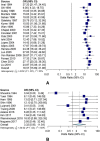Association between Epstein-Barr virus infection and gastric cancer: a systematic review and meta-analysis
- PMID: 32487043
- PMCID: PMC7268387
- DOI: 10.1186/s12885-020-07013-x
Association between Epstein-Barr virus infection and gastric cancer: a systematic review and meta-analysis
Abstract
Background: Numerous studies conducted over the past 30 years have pointed to the presence of Epstein-Barr virus (EBV) in gastric cancer samples. This study was aimed to provide a meta-analytic review of the prevalence of EBV in gastric cancer patients, and to clarify the relationship between EBV infection and gastric cancer.
Methods: A literature search was performed electronically using online databases for English language publications until July 1, 2019. The pooled EBV prevalence and 95% confidence intervals (CIs) were estimated using a random-effects model. To determine the association between EBV and gastric cancer, pooled odds ratio (OR) and its 95% CI were computed for case-control studies. Two separate analyses were performed on data from case-control studies with matched and non-match pairs designs to calculate the pooled estimates of ORs.
Results: The pooled prevalence of EBV in 20,361 gastric cancer patients was 8.77% (95% CI: 7.73-9.92%; I2 = 83.2%). There were 20 studies with matched pairs design, including tumor and tumor-adjacent normal tissue pairs from 4116 gastric cancer patients. The pooled ORs were 18.56 (95% CI: 15.68-21.97; I2 = 55.4%) for studies with matched pairs design and 3.31 (95% CI: 0.95-11.54; I2 = 55.0%) for studies with non-matched pairs design. The proportion of EBV-associated gastric cancer among male cases was significantly higher than among female cases (10.83%, vs. 5.72%) (P < 0.0001). However, the pooled OR estimate for EBV-associated gastric cancer was significantly higher among females (21.47; 95% CI: 15.55-29.63; I2 = 0%) than in males (14.07; 95% CI: 10.46-18.93; I2 = 49.0%) (P = 0.06). EBV was more prevalent in the cardia (12.47%) and the body (11.68%) compared to the antrum (6.29%) (P = 0.0002).
Conclusions: EBV infection is associated with more than 18 times increase the risk of gastric cancer. Although the prevalence of EBV was higher in male patients than in female patients with gastric cancer, women are more likely than men to develop EBV-associated gastric cancer. Our findings showed that using tumor-adjacent normal tissues as the control group provides more robust and accurate results regarding the relationship between EBV infection and gastric cancer.
Keywords: EBV; Epstein-Barr virus; Gastric cancer; Gastric carcinoma; Meta-analysis; Stomach cancer.
Conflict of interest statement
The authors have no conflict of interest.
Figures





References
-
- Bray F, Ferlay J, Soerjomataram I, Siegel RL, Torre LA, Jemal A. Global cancer statistics 2018: GLOBOCAN estimates of incidence and mortality worldwide for 36 cancers in 185 countries. CA Cancer J Clin. 2018;68(6):394–424. - PubMed
-
- Burke A, Yen T, Shekitka K, Sobin L. Lymphoepithelial carcinoma of the stomach with Epstein-Barr virus demonstrated by polymerase chain reaction. Mod Pathol. 1990;3(3):377–380. - PubMed
Publication types
MeSH terms
LinkOut - more resources
Full Text Sources
Medical
Miscellaneous

